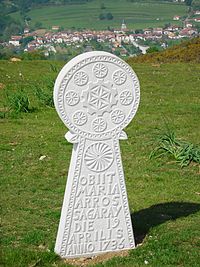Basque mythology
This article needs additional citations for verification. (May 2009) |

The mythology of the ancient Basques largely did not survive the arrival of Christianity in the Basque Country between the 4th and 12th century AD. Most of what is known about elements of this original belief system is based on the analysis of legends, the study of place names and scant historical references to pagan rituals practised by the Basques.
One main figure of this belief system was the female character of Mari. According to legends collected in the area of Ataun, the other main figure was her consort Sugaar. However, due to the scarcity of the material it is difficult to say if this would have been the "central pair" of the Basque pantheon. Based on the attributes ascribed to these mythological creatures, this would be considered a chthonic religion as all its characters dwell on earth or below it, with the sky seen mostly as an empty corridor through which the divinities pass.
Christianity in the Basque Country

The Christianization of the Basque Country has been the topic of some discussion. Broadly speaking there are two views: either Christianity arrived in the Basque Country during the 4th and 5th century, or this did not occur until the 12th and 13th century.[1] The main issue lies in the different interpretations of what is considered Christianization. Early traces of Christianity can be found in the major urban areas from the 4th century onwards, a bishopric from 589 in Pamplona and three hermit cave concentrations (two in Álava, one in Navarre) were in use from the 6th century onwards.[1] In this sense, Christianity arrived "early".
At the same time, various historical sources and research directly or indirectly bear witness to the fact that large-scale conversion did not begin to take place until the 10th and 11th century:
- the bishops of Pamplona were frequently absent from the Synods of Toledo during the Visigoth period[1]
- reports of a failed mission by Bishop Amandus around 640 AD[1]
- Arab authors from the time of the Umayyad conquest of Hispania labeled the Basques as being mağūs or "wizards, pagans"[1]
- the famous cemetery of Argiñeta in Biscay from around 880 AD with Basque gravestones totally devoid of any Christian symbols[1]
- the comparatively low density of religious centers in the Atlantic Basque Country until the 15th century[1]
Most Vasconists broadly agree that Christianity thus arrived some time in the 4th/5th century. Serious missionary and religious activity only began in the 9th century from the kingdom of Asturias and Franks, and continued after the Reconquista with famous monastic foundations (Monastery of Leyre, San Millán de la Cogolla) and the diocese of Bayonne in the 11th century. Thus Christian and non-Christian beliefs lived side by side past the 10th and 11th century. Various traditions connected to this ancient belief system have survived partly by adapting a Christian veneer or by turning into folk traditions, as happened elsewhere in Europe.
However, in spite of the process of Christianization being completed late, the process was thorough and very little direct evidence remains of pre-Christian beliefs. For this reason research into the matter tends to be putative as it has to rely on the analysis of folklore, folk traditions, sketchy references and place-name evidence.[2][3][4][5]
Historical sources
The main sources for information about non-Christian Basque beliefs are:[1]
- Strabo who mentions the sacrifice of male goats and humans.
- Arab writers from the time of the Umayyad conquest of Hispania
- The 12th century diary of the pilgrim Aymeric Picaud
- Various medieval sources making references to pagan rituals, including the records of the Inquisition
- 19th and 20th century collections of myths and folk-tales, for example by José Miguel Barandiaran. This is by far the largest body of material relating to non-Christian beliefs and practices
- the modern study of place-names in the Basque Country
Mythological creatures and characters
The Urtzi controversy
Urtzi may or may not have been a Basque mythological figure. There is evidence that can be read as either supporting or contradicting the existence of such a deity. To date neither theory has been able to convince fully.[6]
Myths of the historical period
After Christianization, the Basques kept producing and importing myths.
- Jaun Zuria is the mythical first Lord of Biscay, said to be born of a Scottish princess who had an encounter with the god Sugaar in the village of Mundaka.
- The battle of Roncesvalles was mythified in the cycle of the Matter of France.
- In the Aralar Range, Saint Michael was said to appear to assist a local noble turned hermit.
- The coat of arms of Navarre was said to come from a feat in the battle of Las Navas de Tolosa.
- The battle of Amaiur was the battle where Navarre lost its independence to the Crown of Castile.
Notes
- ^ a b c d e f g h Kasper, M. Baskische Geschichte (1997) Primus ISBN 3-89678-039-5
- ^ Trask, L. The History of Basque Routledge: 1997
- ^ Collins, R. The Basques Blackwell: 1986
- ^ Gimbutas, M. The Living Goddesses University of California Press: 2001
- ^ Kasper, M. Baskische Geschichte Primus: 1997
- ^ Trask, L. The History of Basque Routledge: 1997
References
- Ortíz-Osés, A. Antropología simbólica vasca Anthropos, 1985. El matriarcalismo vasco Universidad de Deusto, 1988. El inconsciente colectivo vasco, 1982.
- Barandiaran, J.M. Mitologia Vasca Txertoa, 1996
- Hartsuaga, J.I. Euskal Mitologia Konparatua, Kriseilu, 1987.
- La Paglia, Antonio. Beyond Greece and Rome: Faith and Worship in Ancient Europe, Black Mountain Press, 2004.
- Everson, M. Tenacity in religion, myth, and folklore: the Neolithic Goddess of Old Europe preserved in a non-Indo-European setting, Journal of Indo-European Studies 17, 277 (1989). [1]
- Satrústegi, J (1996). "Haitzuloetako euskal mitologia". Euskal Mitologia. 68: 165–174.
- Arriaga, J. (1984). "Euskal mitologia". Gero.
- Baroja, Caro (1995). "Lamiak, sorginak eta jainkosak". Gaiak (Euskal mitologia).
